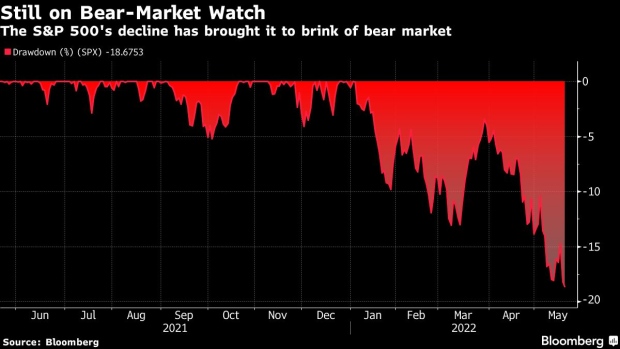May 20, 2022
Bull Market Near-Death Experiences Are Weirdly Common in History
, Bloomberg News

(Bloomberg) -- It could only matter to a statistician: the S&P 500’s late-day bounce kept it from closing 20% below its last record, averting the most curmudgeonly definition of a bear market. For now.
To Wall Street analysts trying to keep pace, it’s another twist in a baffling year. But for market historians, it can’t help but ring a faint, bullish bell.
For the record: the S&P 500 fell all the way to 3,810 during Friday’s session, or roughly 20.6% below its record close of Jan. 3, then rebounded to cut the loss to 18.7%. The levels could be dismissed as trivial except for a nagging fact: history holds an improbably large number of examples of such rebounds lasting. In 1998, 2011 and 2018, the benchmark slid either below the 20% level or very near it on an intraday basis -- only to reverse itself and never test the bear-market waters again.
“All bottoms, short-term or long-term, are formed by short-term traders, and when the S&P drops about 20%, they tend to dip their toes back in,” said Matt Maley, chief market strategist at Miller Tabak + Co.
The S&P 500 rallied all the way back from a 2.3% drop to close higher by a less than a point on Friday. It couldn’t avert a seventh straight weekly drop, though, the longest stretch of futility since 2001.
Another fact to recall from those near-death experiences of the past: how bullish they ended up being. Consider the 19.4% drop from April 29 to Oct. 3, in 2011, for instance. At that bottom, the gauge experienced three days of gains greater than 1.5% -- and continued on to its best month in 20 years. The recovery paved the way for the longest bull market ever recorded, the one that ended in the Covid crash.
Something similar happened in 1998, when the benchmark suffered a drop greater than 19%, bottoming on Oct. 8, before a 2.6% rally spared it from oblivion. From October’s start to the end of January the following year, the gauge surged nearly 25%.
In 2018, the bull market got within points of a 20% plunge on Dec. 24 before turning on a dime right after Christmas. Six days later began a year in which the S&P 500 surged 29% and the Nasdaq 100 rose 38%.
From 2018: Whiff of Extinction Blows in Bull Market That Outlived Them All
Staying above that 20% level is psychologically important, says Maley. “When it does hold and gain some traction, then the longer-term investors come in and the rally starts to feed on itself,” he added.
Julian Emanuel, chief equity and quantitative strategist at Evercore ISI, says 2018, 2011 and 1998 have been on his mind. “These three episodes notably occurred around periods of Fed tightening and did not accompany US recession,” he wrote in a note. His firm doesn’t predict a recession to happen this time, either.
To be sure, betting that Friday’s price action means a bear market will be averted is to misconstrue the rules of probability. The sample in which past reversals took hold is too small -- just three. Moreover, it’s only by the the most nitpicky definition that stocks aren’t in a bear market already. Sentiment has been throttled, earnings are in doubt, and several other big equity benchmarks -- among them the Nasdaq 100 and Russell 2000 -- have dropped by the requisite percentage.
One could also argue that with the equity rout persisting for more than four months, the hit to investor psychology is already done. By now, this retrenchment is longer than three other bear markets.
While the definition of a bear market is up for debate, it possesses a weirdly predictive link to the real world. Fourteen times the S&P 500 has completed the requisite 20% plunge in the last 95 years. In just three of those episodes did the American economy not shrink within a year. Among 14 recessions over the span, only three weren’t accompanied by a bear market.
“The market is typically way ahead of economic data, so the market is already feeling it -- there’s no question about it,” said Scott Bauer, chief executive officer of Prosper Trading Academy. “Something has to pop here.”
©2022 Bloomberg L.P.





